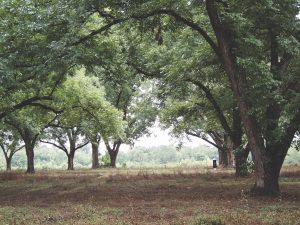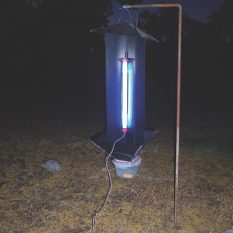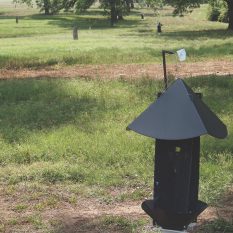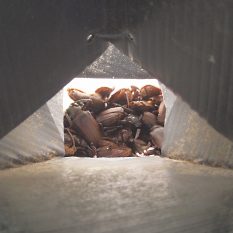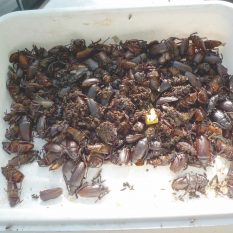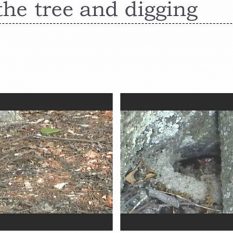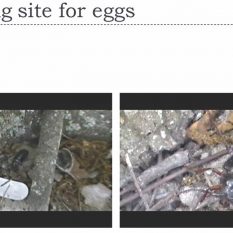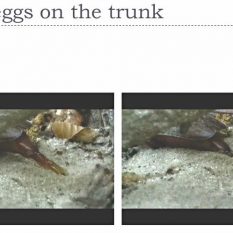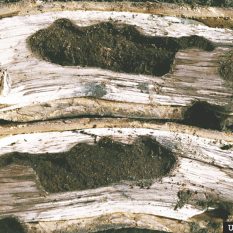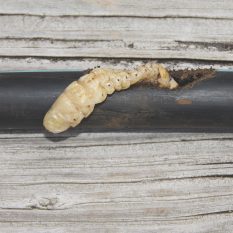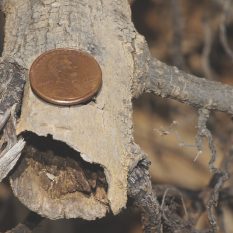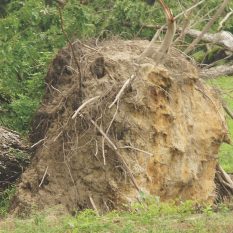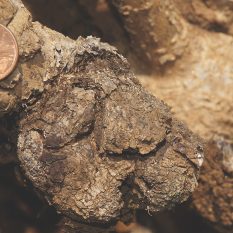Prionus root borers in pecan orchards
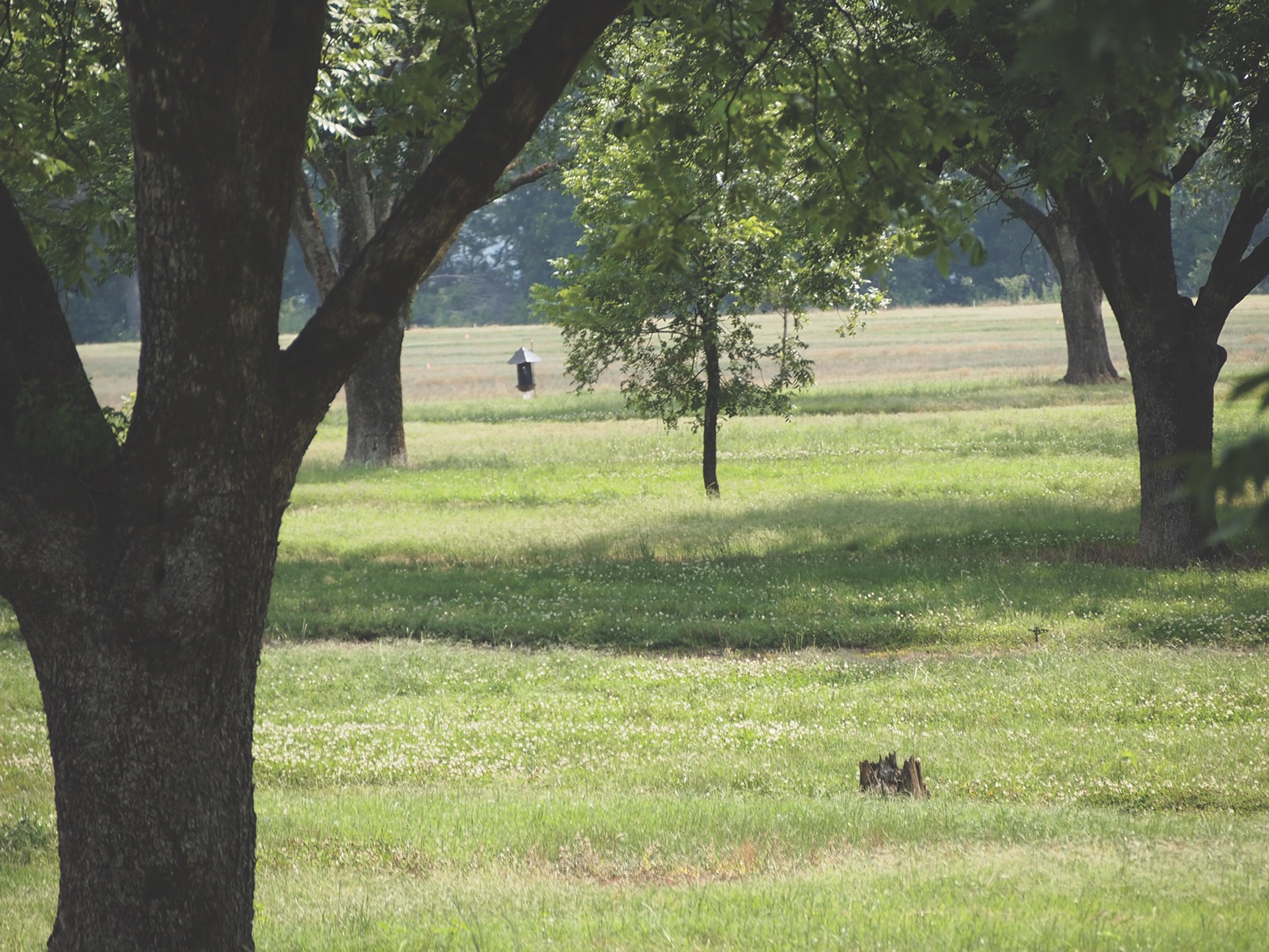
Orchards that have been in decline typically have new trees planted next to the stump of the old tree.
The larvae of these large beetles attack the trees at the roots, cutting off the flow of water and nutrients to the tree and reducing the anchorage of the tree in the soil, thus causing the trees to topple in high winds. The outward appearance of damage is a gradual loss of nut and leaf production on the peripheral branches and progressing to the larger limbs and eventually death of the tree.
Both beetles have similar life cycles and habits. They have several wild tree species as host plants and can move from the wild hosts into the orchard. Natural enemies include soil-borne insect pathogenic fungi and entomophillic nematodes against the soil inhabiting life stages, and birds and rodents prey on the adults above ground.
Chemical control is possible with treatment of the soil and large roots exposed to the soil surface with a chlorpyrifos spray. Your local Extension service can give you the latest control recommendations. Research, funded by USDA/NIFA, and grants from the Georgia Agricultural Commodity Commission for Pecans, Cannon Farms and Dow AgroSciences, at the UGA-Coastal Plain Experiment Station in Tifton, has been conducted over the past 5 seasons testing new control methods for both root borers using a matrix of pheromone-baited traps to trap out and kill the male beetles before they mate plus soil insecticide treatments to protect the tree trunks and exposed roots.
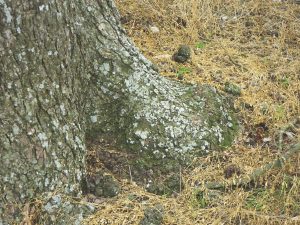
Many root-borer-infested pecan orchards are also heavily infested with crown gall on the roots. The crown gall is a bacteria and pecan trees are naturally resistant to bacterial diseases, however, the bacteria can infest the roots and collar of the trunk through wounds that occur after disking the soil or root borer injury.
Many growers in the U.S. with declining older trees are interested in determining the cause of the decline and this article offers some new information on trapping and control of root borers based on our current research. A regional effort is planned for 2014 in Florida, Georgia and Texas to determine the bionomics of the 2 borers and to develop monitoring and control methods that will be effective across a broad region of the pecan-producing states.
The attraction of the root borer pests of pecan – Prionus imbricornis Drury and Prionus laticolis L. [Coleoptera: Cerambycideae] – to prionic acid, the pheromone of Prionus californicus Motschulsky (Barbour et al 2011), indicates that this pheromone may have some practical application in commercial pecan orchards. Prionus imbricornis is commonly called the tile-horned prionus and P. laticolis is commonly called the broad-necked root borer. The field biology and damage impact of P. imbricornis and P. laticolis in Georgia are well-known (Payne et al 1975, 1976).
The adult beetles are typically found in the pecan orchards from May through July. Males are attracted to black light traps and pheromone-baited traps in high numbers. Ethanol and terpenes are attractive to cerambycid beetles (Miller 2006). Female tilehorned prionus have been attracted to pitfall traps baited with alpha-pinene in my pecan trials.
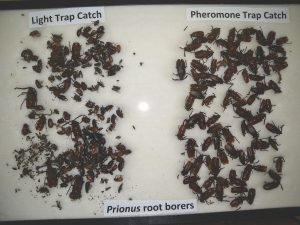
Comparison of the trap catches from side-by-side traps of the two types on the same 24-hour period indicates that the light trap collects fewer Prionus beetles than the pheromone-baited trap. Also, the light trap collects any insect attracted to the light and the pheromone-baited trap only collects Prionus beetles.
Controlling the beetles before they injure the trees, so far, has eluded applied entomologists. Current pecan trials found that the traps need to be set out in early May and remain out through July. A distance between traps of about 800 feet collects more beetles per trap than closer spacing. Emergence in middle Georgia (Perry, GA) is about 2 weeks later than in South Georgia (between Albany and Leary, GA). The life cycle takes 5 years to complete.
Beetles emerge from the soil from May through July with tile-horned prionus emerging earlier in the season and in higher abundance that the broad-necked root borer. The male beetles search for mates and are attracted to a pheromone that is released by the female beetle. The pheromone can attract male beetles from as far as 800-1000 feet from the source (Barbour 2009). The beetles mate and the females start digging in the soil to prepare a place to lay the eggs. The eggs are laid below the soil surface and near the pecan roots.
The larvae bore into the roots and feed and grow for 3-5 years. Injury by the larvae results in gouge-like wounds in live pecan roots. As we mentioned, this root boring injury can also cause decline of pecan trees. Studies (Sparks et al 1974) found that root borers can destroy 75-90 percent of the root system leading to tree decline and death. Apparently, if the larva outgrows the root it is feeding on, it will migrate through the soil to a new root. If the larva encounters an underground drip irrigation line, on its way to the new root, it will cut through the line and leave a large elongate hole in the line.
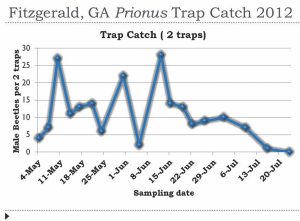
Adult emergence typically begins in early May and continues through to the end of July as indicated by this series of samples taken by Scott Carlson of the UGA-Extension Service at an orchard in Fitzgerald, Georgia.
Treatment of the soil around the base of the tree trunk with sprays of chlorpyrifos (Lorsban Advance, Dow AgroSciences) at an 8-ounce formulation per 50 gallons of spray effectively controls the adult beetles. Our research indicates that the efficacy is approximately 92 percent. It is important to treat all the area around the trunk and any exposed crown gall outcroppings or roots to effectively control the females before they lay eggs.
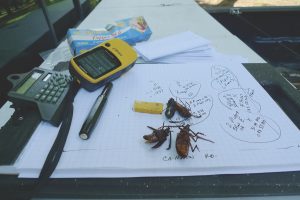
Our research during 2013 and continuing on in 2014 is testing the pattern and density of traps that is needed to trap a good portion of the males before they mate. We measure the GPS coordinates for each trap to set out an even matrix of traps.
Before control options are considered, the grower has to decide whether or not to save the declining pecan trees. If the tree is not producing pecans and has been declining for several seasons, the root borers may have already caused injury from which the tree will never recover. A better decision in this case may be to remove the tree and replant with a new tree or transplant an older tree in the same spot. Regardless, the saved tree or the replacement tree will have to continue to be protected from injury by controlling the borers. Our research will continue in 2014 to determine the effectiveness of the pheromone-baited traps and the soil sprays against the root borers
Currently growers with declining pecan trees can set out pheromone-baited traps in late April to detect the beetles and get an idea of the relative abundance in the orchard. The emergence pattern can be determined by running the traps through July.
Sources for root borer trapping materials are as follows. The pheromone lures are available from: ConTech Enterprises Inc., 115 – 19 Dallas Rd., Victoria BC V8V 5A6 Canada. You can call them at 1-800-767-8658 or send an email to customerservice@contech-inc.com. The item number is 300000887 and is listed as “Prionus root-borer (Prionus spp.) pouch trap lure” at this web address.
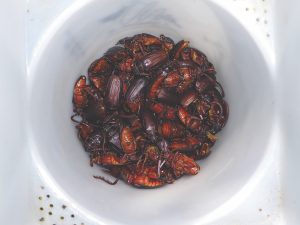
The insect-treated strip is an important to the identification of the species in the trap catch as it kills the beetles so that they do not become destroyed by fighting amongst themselves.
You will need one lure per trap and the lure will collect beetles for the entire emergence period. The lure goes into a panel trap (part no. AST0031) and these can be ordered from Alpha Scents, Inc, 1089 Willamette Falls Dr., West Linn, OR 97068, www.AlphaScents.com and the recent price is $26 per trap.
The traps for root borer female traps are a simple pitfall trap made by setting a 5-quart plastic pail into the ground so that the lip of the pail is level with the ground. The lure is placed in a plastic pudding container with a screen top and suspended above the bottom of the trap with a piece of wood lathe. The alpha-pinene lures (item no. APINLO) are commonly used in forest entomology and are available from Alpha Scents as well, at a recent price of $5 per lure. One ConTech pheromone lure will last for the entire emergence period under Georgia conditions, whereas, the alpha-pinene lures need to be changed out every 4 weeks.
Pecan trees decline in response to many factors. Root-boring beetle larvae are just one factor that causes the decline. Detection is key to determining if the beetles are a factor in the decline of tree productivity in the orchards. Prionus root borers are detected with pheromone-baited traps or light traps or pitfall traps. Nearly every orchard has a few root borers present. Serious infestations will have very high trap catch during late May and early June of 30 or more beetles per trap per day in the pheromone-baited panel traps.
Once the pests are identified and the severity of the problem is determined control measures can be applied. Current controls are effective but need to be improved through research. This article, however, reports results of research in progress and does not constitute a control recommendation by the author or the University of Georgia, Texas A&M University, or the University of Florida.
The most effective control methods are found in the recommendations of your State Cooperative Extension Service. Thanks to Lane, Walker and Cannon Farms, Nilo and Muckalee Plantations, and other cooperating pecan growers for supplying areas to set out traps.

